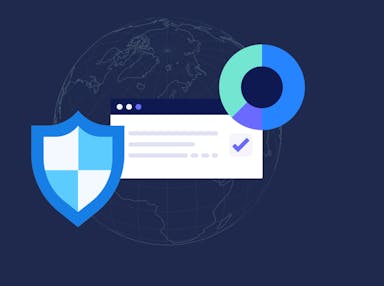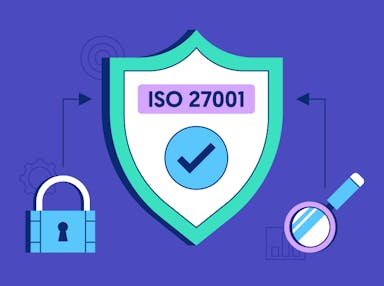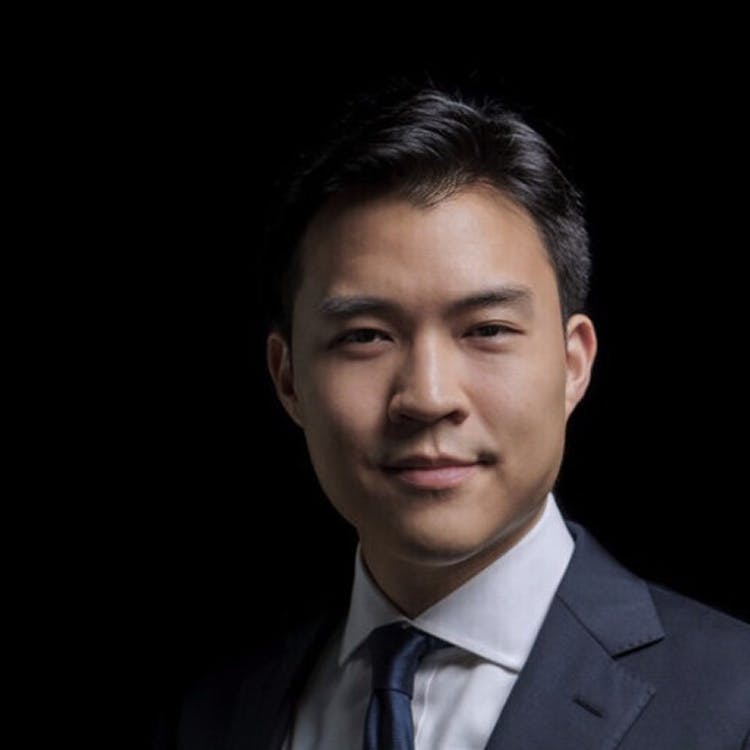
ISO 9001: How to Get Certified Faster and Easier Using Automation [+ Checklist]
Anna Fitzgerald
Senior Content Marketing Manager
Cavan Leung
Senior Compliance Manager
The International Organization for Standardization (ISO) has created some of the best-known standards for information security management systems — but that’s not all. It has also created the world's best known standard for quality management systems (QMS), ISO 9001.
ISO 9001 is used by over one million organizations in 189 countries to improve the quality of their products and services and consistently meet their customers’ expectations. Learn more about ISO 9001, its requirements, and the certification process below.
What is ISO 9001?
ISO 9001 is an internationally recognized quality management framework. It is designed to help organizations consistently meet the needs and expectations of their customers as well as applicable statutory and regulatory requirements and continuously improve their processes and overall performance to ultimately achieve a high quality product and/or service.
ISO 9001 belongs in the ISO 9000 family of standards. It is the world’s best known standard for quality management. The rest of the ISO 9000 family are supporting standards on quality management. The family was published by ISO and its subcommittees.
What’s the latest version of ISO 9001?
First published in 2009, ISO 9001 was updated in 2015. ISO 9001:2015 remains the latest version of the standard. In 2021, it underwent a systematic review to decide whether it is still valid or needs updating. The result was that no revision was needed and that ISO 9001:2015 still provides as much value to those implementing the standard as it did when it was last updated in 2015.
What is the purpose of ISO 9001?
The purpose of ISO 9001 is to provide a structured framework for organizations to establish and maintain a Quality Management System (QMS). This framework helps organizations provide customers with consistent, good-quality products and services, which in turn results in multiple benefits, including:
- Enhanced customer satisfaction
- Quality process improvement
- Reduced costs and inefficiencies
- Continuous improvement to their quality management systems

ISO 9001 requirements
ISO 9001 outlines a set of requirements that organizations must meet to establish, maintain, and continuously improve a QMS. These requirements include:
- Context of organization: Organizations must understand how external and internal factors will likely affect their ability to achieve the intended results of their QMS. This may involve presenting documents like business plans and strategies, annual reports, and process maps.
- Leadership: Top management must demonstrate leadership and commitment to the QMS.
- Planning: ISO 9001 requires organizations to identify quality objectives, risks, and opportunities outline how they will take action to address them. This may include setting objectives, setting up internal systems and processes, and determining process interactions.
- Support: Organizations must provide the documentation, communication, processes, training, human and infrastructure resources, and work environment necessary to understand, implement, and maintain ISO requirements.
- Operation: ISO 90001 requires organizations to plan, implement, and control the processes necessary to meet customer requirements and increase customer satisfaction. This includes external processes involving suppliers and contractors.
- Performance Evaluation: Organizations must monitor, measure, analyze, and evaluate the performance of the QMS against their objectives.
- Continuous improvement: ISO 9001 requires organizations to continuously increase the effectiveness of the quality management system based on the results of performance evaluations.
Please refer to the official ISO 9001 publication for a detailed list of controls and requirements.
What is ISO 9001 certification?
To implement ISO 9001, organizations must put effective processes in place and train their staff to deliver high-quality products or services consistently. As with other ISO standards, organizations that implement ISO 9001 can go through a certification process but aren’t required to do so.
Certification to ISO 9001 demonstrates to customers and key stakeholders that you are committed and able to deliver quality products or services time and time again. An accredited audit firm must be utilized to audit the organization against the standard and to issue a certificate. The accreditation body provides oversight and independent confirmation of the audit firm's competence and procedures to perform ISO audits and issue certificates.
The organization must also perform internal audits to check that its quality management system is working effectively.
Who needs ISO 9001 certification?
Any organization that wants to improve its quality management system, meet customer and applicable statutory and regulatory requirements, and enhance customer satisfaction and trust — regardless of its type, size, or industry — can certify to the ISO 9001 standard. It applies to all sectors, including manufacturing, services, healthcare, education, government, and non-profit organizations.
Because it applies so widely, ISO 9001 is one of the most popular ISO management standards. In fact, according to a recent ISO survey, ISO 9001 had the highest number of certificates issued in 2022 of all ISO management standards, with over 1.26 million valid certificates issued.
How to get ISO 9001 certification
To achieve ISO 9001 certification, you’ll need to complete several steps. Here’s what you can expect when preparing for and completing your certification.
Step 1: Establish a ISO 9001 team and get executive buy-in
To start, appoint members of your organizations to take charge of the certification process. This team will have several responsibilities, including determining the scope of your QMS, establishing processes for documenting it, communicating the ISO 9001 certification process to all employees, and working directly with the auditor, among other duties. They will also need to get support from top management since they are required to demonstrate leadership and commitment to the QMS.
The roles and responsibilities of the ISO 9001 project team should be clearly documented and communicated to the organization.
Step 2: Scope your QMS
Next, you’ll need to define the scope of your QMS. This requires you to identify what products and/or services, regulatory requirements, activities, remote locations, and facilities are supported and documented by your QMS.
For some companies, the scope of their QMS includes their entire organization. For others, it includes only a specific product or service that includes the relevant department(s), system(s), and/or location(s).
Step 3: Perform a gap analysis and risk assessment
Next, perform a gap analysis to understand your strengths and weaknesses with respect to the ISO 9001 standard. If you identify any nonconformities, correct them by implementing or modifying controls to adhere to the ISO 9001 requirements.
At this time, you should also perform a risk assessment. ISO 9001 requires organizations to implement a process to identify, determine, and evaluate risks and opportunities related to QMS performance and take appropriate actions to address them. This may require developing or modifying controls to align with your risk mitigation strategy.
Step 4: Document evidence
You’ll need to document your policies and processes to prove that you’ve satisfied ISO 9001 requirements. The more work you do to shore up your documentation before the audit, the better your chances of achieving certification. Automation can significantly simplify and speed up this process.
During this phase, your organization should also be educating your general staff about quality management, your QMS, and ISO 9001 certification in particular. By having your whole staff pull together, you greatly reduce the likelihood of leaving unaddressed gaps in your QMS.
Step 5: Internal audit
Conduct an internal audit to evaluate your current QMS and identify and remediate any gaps before the external audit. Treat this like a dress rehearsal that will help you prepare for the actual audit.
Consider making a list of findings and their potential impact and corrective actions that must be taken.
Step 6: External audit
Have an accredited auditor assess your QMS against ISO 9001 requirements. As stated above, you would need an accredited audit firm to perform this audit and issue a certificate since it can provide customers with an additional layer of confidence that the issued certificate is a valid one.
Step 7: Maintain compliance
After getting ISO 9001 certification, make a plan for maintaining compliance. This should include setting up a process for continuous monitoring and yearly internal audits. If you use Secureframe, we’ll integrate directly with your company's core services in order to continuously monitor and identify nonconformities with respect to ISO 9001 compliance.
You’ll need to be recertified every three years to ensure your commitment to a compliant QMS hasn’t lapsed.
Recommended reading

6 Benefits of Continuous Monitoring for Cybersecurity
ISO 9001 internal audit checklist

ISO 9001 internal audit checklist
Use this checklist to guide your internal audit process to assess how your organization is satisfying ISO 9001 requirements.
ISO 9001 vs 27001
The key difference between these ISO standards is that ISO 9001 defines requirements for establishing, implementing, maintaining, and continually improving a quality management system and ISO 27001 does the same for an information security management system (ISMS). In other words, the ISO 9001 framework determines whether an organization has built a QMS capable of delivering high-quality products or services consistently, and ISO 27001 determines whether an organization has built an ISMS capable of protecting sensitive data.
Getting certified to either can help unlock a range of benefits, including building trust with customers and stakeholders, providing a powerful competitive advantage, and simplifying compliance with other standards and regulations — including each other.
There are key similarities between the main clauses of ISO 9001 and ISO 27001, like:
- Both require organizations to identify internal and external factors that may affect the outcomes of their management systems.
- Both require organizations to determine the interested parties and requirements of those parties that are relevant to the management system.
- Both require determining the scope of the management system.
- Both require top management to demonstrate leadership and commitment to the management system.
- Both require that roles and responsibilities for the management system be defined.
- Both have requirements around competence, awareness, communication and documented information that can be met in the same way and/or at the same time.
- Both require a process for addressing nonconformities and taking corrective action.
- Both emphasize continual improvement.
Because of these benefits and similarities, some organizations implement an integrated management system (IMS) and pursue certification to both ISO 9001 and ISO 27001. This ensures the organization’s QMS and ISMS meet the requirements of the standards, while reducing duplicate work.
Using a compliance automation tool with common controls and control mapping capabilities like Secureframe can simplify this process. Common controls are mapped to requirements across multiple frameworks. After implementing these controls, you can test them once to validate that they are effective and use these results as evidence of adherence to requirements across multiple frameworks. Organizations can therefore achieve compliance with multiple frameworks faster and avoid duplicate work.
So say your organization has already invested time and resources in achieving compliance for ISO 27001, then by using Secureframe, you can effectively extend your compliance efforts to meet ISO 9001 requirements without starting from scratch.
Recommended reading

ISO 27001 Checklist: Your 14-Step Roadmap for Becoming ISO 27001 Certified
How Secureframe can help your organization comply with ISO 9001 and other frameworks
Secureframe can help streamline and speed up time-to-compliance for ISO 9001 and other frameworks, while streamlining operations and cutting down on costs. Use Secureframe to unlock the following benefits:
- Compliance source of truth: See all of your policies and documentation in one place and automatically collect evidence for internal review.
- Automated evidence collection: Automate manual evidence collection utilizing 200+ out-of-the-box integrations with tests that are mapped directly to ISO 9001 requirements and controls.
- ISO 9001 readiness report: See exactly how close you are to satisfying ISO 9001 requirements and get actionable advice for closing any gaps.
- Task management: Assign tasks to employees within your organization and set notifications to ensure they are completed so you stay audit-ready and compliant.
- Trusted audit partners: Work with one of our recommended auditors to make the audit process as seamless as possible.
- Continuous monitoring: Continuously monitor your systems and controls to maintain a strong security and compliance posture 24/7.
- Control mapping: Controls are mapped to multiple frameworks to speed up time-to- compliance and avoid duplicate work when complying with multiple frameworks, like ISO 9001 and ISO 27001.
Learn more about how Secureframe can streamline security and compliance by scheduling a demo with a product expert.
Use trust to accelerate growth
FAQs
What does ISO 9001 mean?
ISO 9001 refers to the internationally recognized standard for quality management, ISO 9001:2015. It is designed to help organizations consistently meet the needs and expectations of their customers as well as applicable statutory and regulatory requirements and continuously improve their processes and overall performance. ISO 9001 certificates are issued to over a million organizations in over 180 countries per year.
Why become ISO 9001 certified?
There are numerous reasons to pursue ISO 9001 certification including:
- Enhanced Customer Confidence: ISO 9001 certification ensures that companies maintain robust quality control measures, bolstering customer trust and satisfaction.
- Efficient Complaint Resolution: By adhering to ISO 9001 guidelines, organizations can resolve customer complaints promptly and effectively.
- Improved Processes: The standard helps organizations identify and eliminate inefficiencies, minimize waste, optimize operations, and make informed decisions, leading to cost reductions and improved results.
- Continuous Enhancement: Regular internal audits are recommended by ISO 9001, allowing organizations to continuously refine their quality management systems.
How often is ISO 9001 updated?
Published in 2009, ISO 9001 was updated in 2015. It has not been updated since. However, in 2021, it underwent a systematic review to decide whether it is still valid or needs updating. This review confirmed that the latest version of ISO 9001 still provides as much value to those implementing the standard as it did in 2015.
What does ISO stand for in ISO 9001?
ISO stands for the International Organization for Standardization (ISO). ISO is an independent, non-governmental international organization with a membership of 169 national standards bodies that develops and publishes international standards, including ISO 9001.
What is the ISO 9000 family of standards?
The ISO 9000 family consists of ISO 9001 and a set of supporting standards on quality management. This family was published by ISO/TC 176 and its subcommittees.
How long does ISO 9001 certification last?
ISO 9001 certification is valid for up to three years from your certification date. Your company must get recertified every three years to ensure it complies with the latest ISO 9001 requirements.
How many clauses are there in ISO 9001?
There are seven clauses in ISO 9001, each containing a series of requirements:
- Context of the organization
- Leadership
- Planning
- Support
- Operations
- Performance evaluation
- Improvement

Anna Fitzgerald
Senior Content Marketing Manager
Anna Fitzgerald is a digital and product marketing professional with nearly a decade of experience delivering high-quality content across highly regulated and technical industries, including healthcare, web development, and cybersecurity compliance. At Secureframe, she specializes in translating complex regulatory frameworks—such as CMMC, FedRAMP, NIST, and SOC 2—into practical resources that help organizations of all sizes and maturity levels meet evolving compliance requirements and improve their overall risk management strategy.

Cavan Leung
Senior Compliance Manager
Cavan Leung, CSSK, CISA, CISSP is an information security leader with over a decade of experience in the security, privacy, and compliance industries. A former auditor and security consultant, Cavan performed ERP and SOX compliance audits at Deloitte, as well as SOC 1, SOC 2, GDPR, and ISO 27001 compliance assessments for Fortune 500 companies at Schellman. At Secureframe, he’s helped hundreds of customers achieve compliance with SOC 2, ISO 27001, GDPR, HIPAA, and more.